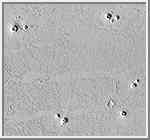|
COMETS EARTH JUPITER KUIPER BELT MARS MERCURY METEORITES NEPTUNE OORT CLOUD PLUTO SATURN SOLAR SYSTEM SPACE SUN URANUS VENUS ORDER PRINTS
PHOTO CATEGORIES SCIENCEVIEWS AMERICAN INDIAN AMPHIBIANS BIRDS BUGS FINE ART FOSSILS THE ISLANDS HISTORICAL PHOTOS MAMMALS OTHER PARKS PLANTS RELIGIOUS REPTILES SCIENCEVIEWS PRINTS
|
Related Documents
Download Options
High-resolution images from the Mars Global Surveyor (MGS) Mars Orbiter Camera (MOC) have revealed small cone-shaped structures on lava flows in southern Elysium Planitia, Marte Valles, and northwestern Amazonis Planitia in the northern hemisphere of the red planet. The most likely interpretation of these cones is that they may be volcanic features known as "pseudocraters" or "rootless cones". They share several key characteristics with pseudocraters on Earth: they are distributed in small clusters independent of structural patterns, are superimposed on fresh lava flows, and they do not appear to have erupted lavas themselves. Located in northwestern Amazonis Planitia near 24.8°N, 171.3°W, this high-resolution image is illuminated from the lower left. The image shows several possible psuedocraters (cone-shaped features with holes or pits at their summits) that occur on top of a rough-textured lava plain. The image is 3 km (1.9 mi) across and approximately 3.7 m/pixel (12 feett/pixel) at full-resolution. Pseudocraters form by explosions due to the interaction of molten lava with a water-rich surface. Possible martian pseudocraters are of interest because they may mark the locations of shallow water or ice at the time the lava was emplaced. Viking Orbiter images have shown structures in other regions of Mars that were interpreted to be pseudocraters, but the interpretations were uncertain because the morphology was poorly resolved, it was unclear if they occurred on volcanic surfaces, and they have diameters as much as a factor of 3 larger than terrestrial pseudocraters. The cone-shaped morphology is well resolved in the cones imaged by MOC, and they have basal diameters of less than 250 m (273 yards), consistent with terrestrial examples. The cones rest on a surface with a distinctive morphology consisting of ridged plates that have rafted apart, which MOC team members have interpreted as the surface of voluminous lava flows. The surface shown here looks relatively fresh and has very few impact craters on it, which suggests that the lava flows and the cones are both geologically young. However, MOC images in other areas reveal such apparently young surfaces being exhumed (presumably by wind erosion) from beneath a blanket of overlying material. Impact processes may harden the blanket, or cover it with materials that cannot be removed by wind, so the wind erosion leaves behind elevated "pedestal craters". The cones shown here are not typical of pedestal craters, but it is important to consider this alternative interpretation. MGS MOC first began taking pictures of Mars in mid-September 1997. The planet that has been revealed by this camera is often strange, new, and exciting. The possibility that lava and water or ice have interacted to create features like psuedocraters indicates that Mars has had a diverse and complex past that researchers are only just begining to understand. The picture shown here is the subject of a talk on MOC views of volcanism on Mars being presented in an invited talk at the Geological Society of America (GSA) Annual Meeting in Denver, Colorado on Monday, October 25, 1999, by MOC scientist Alfred McEwen of the University of Arizona, Tucson. The document "Possible Rootless Cones or Pseudocraters on Mars" contains additional information was will as a wide angle contextual image. |
